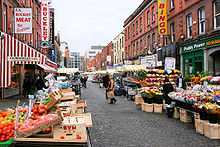Moore Street


Moore Street (Irish: Sráid Uí Mhórdha) is a street in central Dublin, Ireland, off Henry Street, one of Ireland's main shopping streets. The famous Moore Street open air fruit and vegetable market is Dublin's oldest food market.[1]
Many Dubliners have a great affection for Moore Street, and especially its vendors. The market there is considered to be a famous landmark on the northside of the city. The people who work the stalls have a witty and friendly reputation; they and their food stalls are Dublin institutions; and they speak in a strong Dublin accent.
Moore Street was the subject of the second CIVIC LIFE film, by Irish filmmakers Joe Lawlor and Christine Molloy, starring members of the Dublin-based African production company, Arambe.[2]
Easter Uprising
Irish Volunteers commanded by Patrick Pearse surrendered to British forces on 30 April 1916, during the Irish War of Independence from a terrace of houses on Moore Street at the ending of the Easter Rising. Five of the seven signatories of the Irish Proclamation of Independence - Patrick Pearse, James Connolly, Thomas Clarke, Joseph Plunkett and Sean MacDermott, as well as future leader Michael Collins, surrendered from the terrace.[3]
Planning controversy
Dublin City Council planned from 1998 to demolish the terrace to redevelop the area, but this was opposed by groups who held this terrace and the battlefield trail running from the GPO down Moore Lane and Henry Street and into Moore Street to be an important part of Irish history, some referring to the location as "Ireland's Alamo". The National Graves Association began its campaign in 2002, setting up the "Save 16 Moore Street committee" in 2005. Numbers 14-17 Moore Street were declared a national monument in 2007, guaranteeing their retention.[4]
However, plans for a €1.25 billion retail and residential scheme on nearby O'Connell Street, which would be built by Joe O'Reilly (CE of the Chartered Land Group, which developed the Dundrum Town Centre) are controversial. At Easter Rising commemorations in April 2009, opponents of the scheme contended that it would involve major alterations to numbers 14-17 and pledged to challenge it at forthcoming public hearings.[5][6]
Objectors, including families of the signatories of the Irish Proclamation of Independence (all signatories were executed by the British in the fortnight after the Rising), have pledged to seek an EU ruling to preserve the terrace if the developer's plan to subsume it and Moore Lane into the planned mall surrounding the GPO is waved through by the Irish Government. In November 2012, Colm MacGeehin, legal representative for relatives of the 1916 leaders, told the Joint Committee on the Environment, Transport, Culture and the Gaeltacht that Chartered Land accepted they do not have the money to build the development. Joe O'Reilly is in debt to the Irish Bank Resolution Corporation (formerly known as Anglo Irish Bank) to the tune of hundreds of millions of Euros. In the meantime, the interior and exterior of the houses have deteriorated badly.[7]
In popular culture
Moore Street market is shown in the 2014 film, Mrs. Brown's Boys D'Movie. The title character of Mrs. Brown is shown to run a family owned market, passed down from eldest daughter since 1802. The market comes under threat from Russian developers who wish to turn the street into a giant shopping centre.
References
- ↑ Williams, Louise (2001-04-2001). "Ireland awaits Euro price rises". BBC News. Retrieved 2008-07-23. Check date values in:
|date=(help) - ↑ Civic Life
- ↑ "Dublin May Seek Surrender Letter". BBC Northern Ireland. 2006-01-09. Retrieved 2008-07-23.
- ↑ Fleming, Diarmuid (2007-01-19). "Rebel house saved from developers". BBC Northern Ireland. Retrieved 2008-07-23.
- ↑ O'Regan, Michael (2009-04-13). "Protest over 'violation' of monument". Irish Times. Retrieved 2009-04-16.
- ↑ Healy, Alison (2009-04-14). "Memorial urged for women of 1916". Irish Times. Retrieved 2009-04-16.
- ↑ Ó Caollaí, Éanna (10 April 2013). "Call for Taoiseach to save 1916 buildings". Heritage (Dublin). Irish Times. Retrieved 2013-04-12.
External links
| Wikimedia Commons has media related to Moore Street, Dublin. |